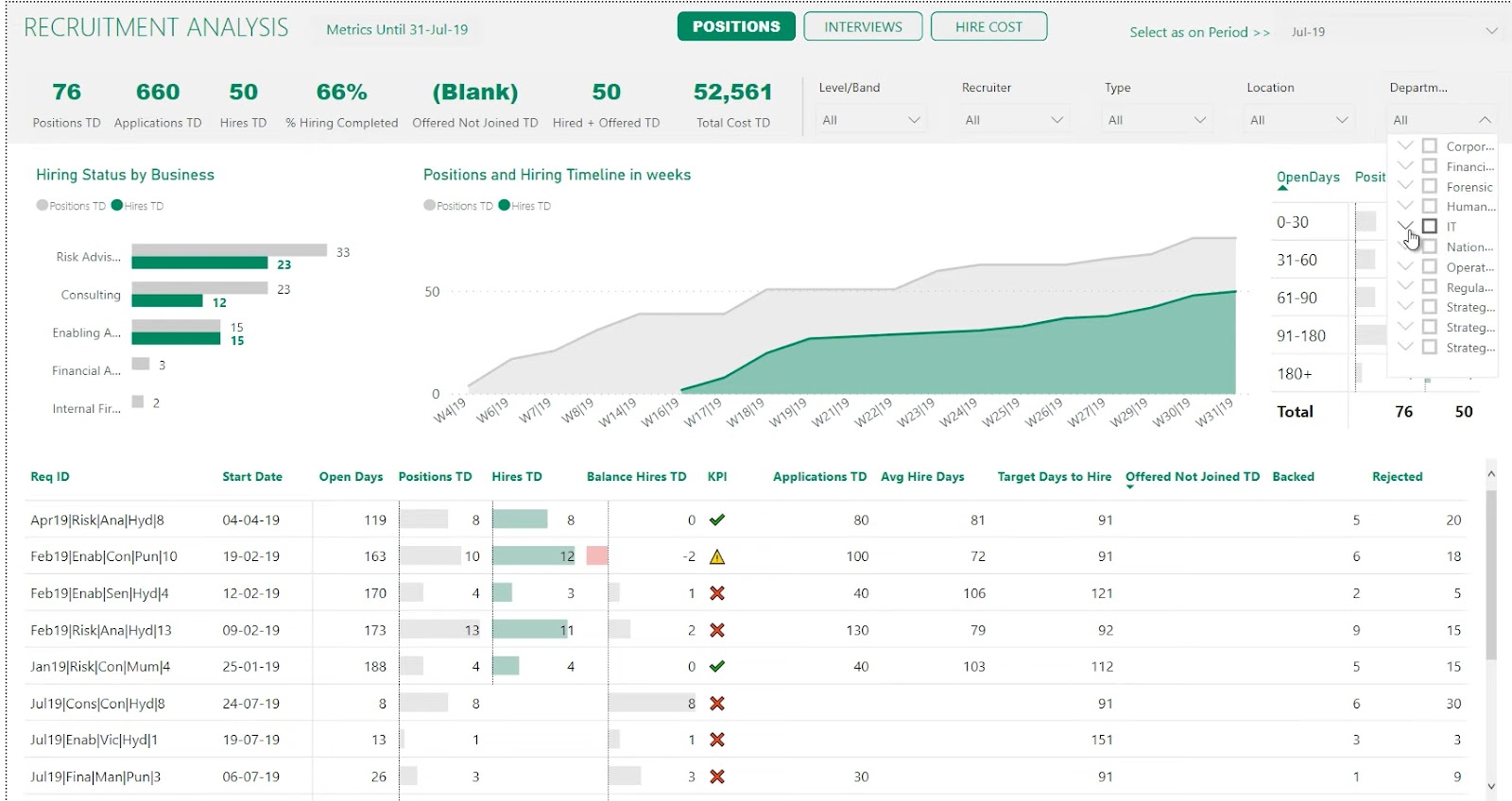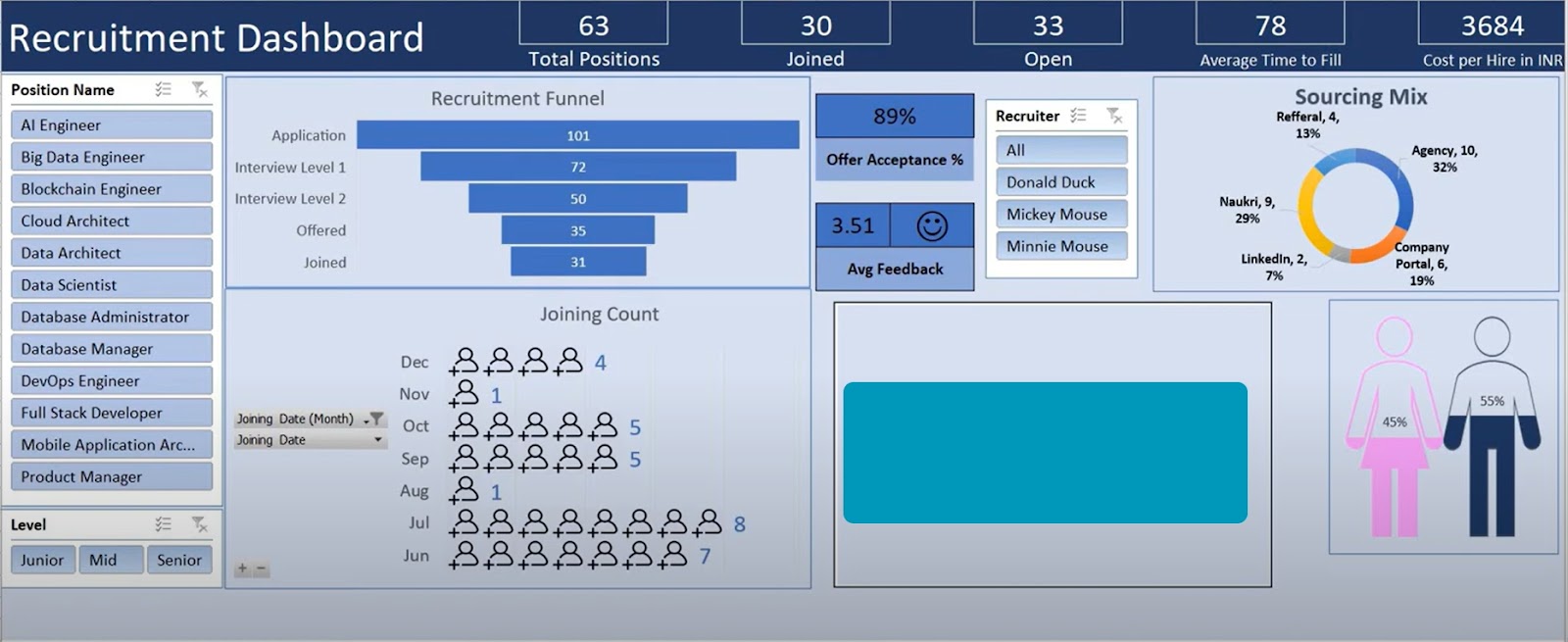Recruiter Dashboards and Their KPIs
Collection and analysis of data are the foundation of process optimization and recruiting is not an exception. This is where recruiting dashboards come in handy. They allow for the collection and comprehensive data presentation so that professionals could get valuable insights into all processes.
Together with Jooble, we've prepared an ultimate guide to the most important KPIs to track in the recruiting process. You'll also learn how to collect and interpret such data as job board information, applicant-to-hire ratio, or retention rate.
| #1 Ranking: Read how InetSoft was rated #1 for user adoption in G2's user survey-based index | Read More |
Why Recruitment Dashboards Are Useful
A recruitment dashboard is a visual collection and representation of various metrics and key performance indicators (KPIs). It also usually features reports on different aspects of the recruiting funnel and its efficiency.
Such dashboards might include all types of data that have to do with recruiting, from budgets to candidates' information.
Why should a department have a recruitment dashboard? Here are the main reasons:
- With the use of proper metrics, the organization can improve the hiring process and reduce related costs;
- It can help come up with new talent acquisition strategies and processes;
- It highlights the potential problems and patterns that need closer attention or optimization;
- It gives a better understanding of the hiring funnel's productivity as a whole.
Overall, it is a foundation for the optimization of the hiring processes of any business or company.
What Metrics Can Be Used?
The selection of specific metrics depends on the company's goals and objectives. There is a multitude of factors that go into recruitment and almost all of them can be tracked and analyzed. But it is essential to know how to track them properly and how to approach interpretation.
Some of the popular metrics used in such dashboards are:
- Quality of hire;
- Time to hire;
- Cost per hire;
- Candidate satisfaction;
- Effectiveness of particular job posting platforms, etc.
One of the difficulties of tracking and evaluating recruiting KPIs is that often several factors might impact a particular result. So the interpretation process itself has to get the same level of attention as data collection.
The Most Important KPIs to Track
Time to hire
This is quite a straightforward metric shows how many days it took from the moment you approached the candidate to them accepting a job offer. This period shows how long it takes to move a candidate through the hiring funnel. Overall, the shorter it takes, the more efficient the funnel. Time might often be an essential factor when it comes to talent acquisition. If the process takes too long, the top candidate might get another offer or move to another employer.
Also, it shows how efficient the recruitment team is with the processes. But it is important to note that every company has its own objectives when it comes to recruiting. Some do need a longer time to hire and several stages of interviews. So this should be taken into account when evaluating this KPI.
Time to fill
This one should not be mistaken for the previous one. Time to fill refers to how many days it takes to fill in the position. Often, it is tracked from the day the job opening is posted to the first day of a new employee of the job.
Here the focus lies on the productivity of the recruiting team and the strategies used. It also gives insights into the demand and supply when it comes to particular positions. For example, entry-level ones are usually much quicker to be filled than advanced ones. This information is useful to understand how much time it might take to hire a new employee if employee X quits or gets fired. By knowing this, the HR department might offer more stability to the organization.
 |
Read the top 10 reasons for selecting InetSoft as your BI partner. |
Applicants per Opening
This KPI refers to the number of applications you get for each particular job posting. It is pretty easy to track and can also give interesting observations. For example:
How popular such positions are on the market;
The demand for specific specialists;
Whether the description is specific enough (if too many unfit candidates apply it might signify that the job posting is too broad).
The department can use this metric to forecast how easy it would be to fill specific positions in case the organization needs to scale up. Also, it is useful to know whether the job description in the opening is specific enough. The fewer unsuitable applications you get, the easier it will be for professionals to process the suitable ones.
Effectiveness of the Recruitment Funnel
This is a more complex metric that showcases how well-designed the hiring funnel is. You can calculate it by breaking down the process into specific stages and tracking the number of people involved in each stage. Also, it is essential to establish the passing rate for candidates moving through the set stages.
The ratio can be calculated based on the total number of applicants for each stage, the number of those, who have completed this stage, and the number of hired specialists.
By tracking this KPI you can understand what stage of the funnel might need more attention or optimization. For instance, there is a high number of initial applicants but only a small part of them move to the face-to-face interview after an initial call. This might be happening because the job opening was too broad and there was a significant number of unsuitable applicants.
 |
View a 2-minute demonstration of InetSoft's easy, agile, and robust BI software. |
The Source of Hire
This KPI shows where the candidates and hires come from. It shows what channels are the most effective and helps optimize recruitment strategies.
The sources can include:
- Referrals;
- Job boards;
- Agencies;
- Company's career page;
- Paid campaigns;
- Social media posts, etc.
If you notice that some channels are significantly more effective, it makes sense to put more focus on them instead of spreading efforts over ineffective ones. It can also help cut disbursements on the channels that show low results.
Cost-Per-Hire
This metric is essential for budgeting and evaluating the overall cost of recruitment for a particular position. It should be evaluated with the use of all money spent on a position, like agency fees, job fairs, paid openings, time to recruiting, interviewing, and onboarding.
You need to establish the total hiring cost and divide it by the number of hires for a position. Interpretation of results allows for optimization of the processes and cutting costs.
Read what InetSoft customers and partners have said about their selection of Style Scope for their solution for dashboard reporting. |
Quality of Hire
It is another complex yet essential metric a recruitment dashboard needs to have. Here the main objective is to identify how fitting and valuable the hire is for the company. The main challenge in tracking this KPI is that it takes a long time and several factors of evaluation.
To estimate the quality of hire, the HR department needs to consider employee performance, retention, productivity, lifetime value, and contribution. It is also possible to add the hiring data to establish the quality (source, time to hire, cost, etc.). The simple formula for this KPI is job performance plus ramp-up time plus engagement plus cultural fit.
Interview-to-Offer
This metric defines how many applicants receive a job offer after an interview. Overall, it shows the quality of candidates and the productivity of the hiring process. Reporting on this KPI might help offer candidates a better experience, reduce hiring costs, deliver a competitive cost to company, or CTC, and give more clarity into key responsibilities and roles, or KRA.
Offer Acceptance
It is one of the most crucial KPIs for a recruitment dashboard. This is the main result of an effective talent acquisition strategy and HR department efforts. A good ratio of offer acceptance shows that your process is efficient and you can correctly figure out the candidate's skills, experiences, and priorities. It also gives insights into proper messaging and tailoring the offers.



